Critical Evaluation of Evidence in Healthcare: HLSC122, Sem 2, 2017
VerifiedAdded on 2020/04/13
|9
|1986
|63
Report
AI Summary
This report presents a critical evaluation of two research articles investigating the effects of smart drugs, specifically psycho-stimulants, on academic performance and executive functioning in university students. The first article, a qualitative study, explores the life context of students using these drugs, while the second examines the relationship between non-medical stimulant use and executive function. The report analyzes the methodologies, findings, strengths, and weaknesses of each study, including the barriers to evidence-based practice. The report concludes that psycho-stimulants do demonstrate some potential side effects on people who use these drugs and the first research article is considered to be more successful as it provides direct evidence of the effects of smart drugs on improved academic outcomes. The report also discusses the alignment of the studies with the PICO framework, providing a comprehensive overview of the evidence related to the use of smart drugs for academic enhancement.
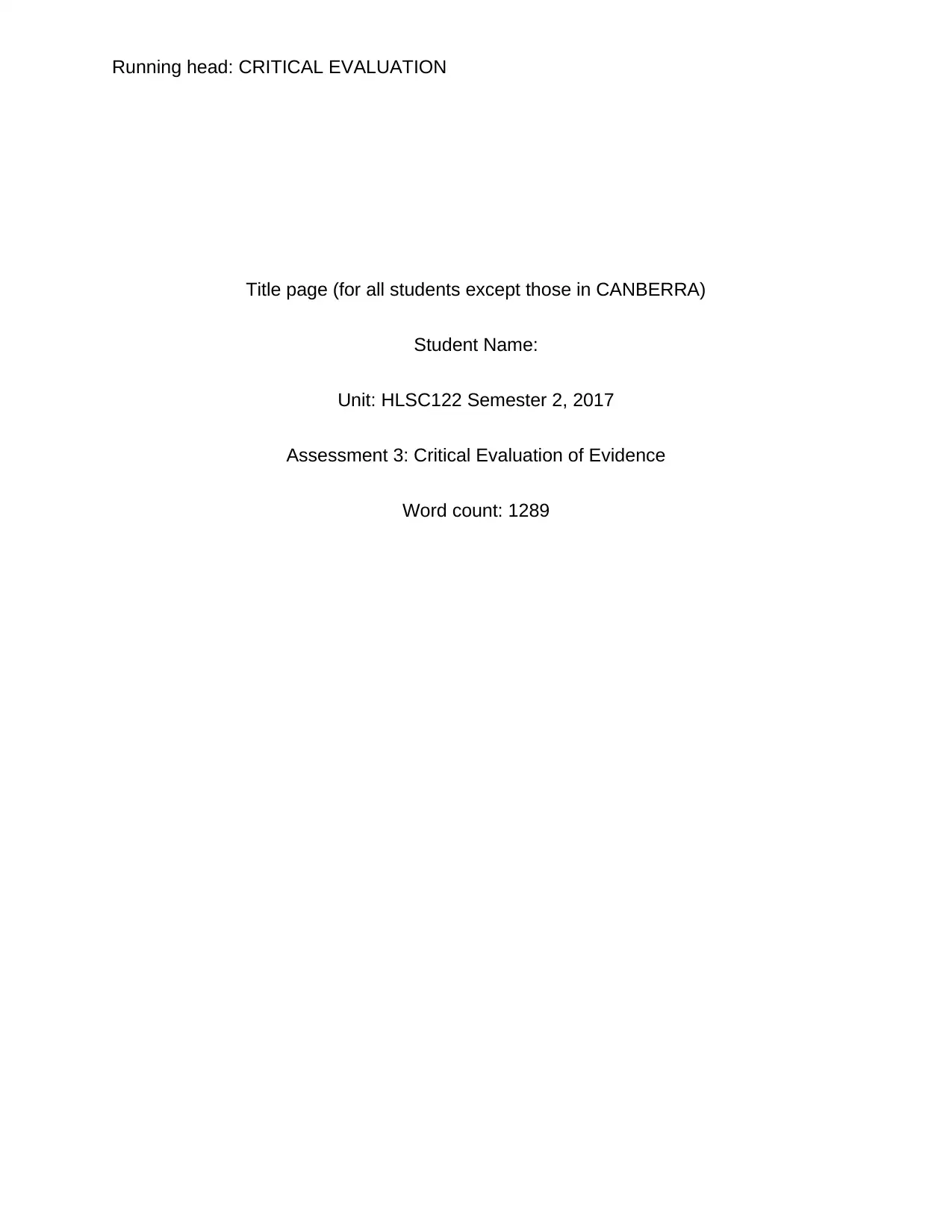
Running head: CRITICAL EVALUATION
Title page (for all students except those in CANBERRA)
Student Name:
Unit: HLSC122 Semester 2, 2017
Assessment 3: Critical Evaluation of Evidence
Word count: 1289
Title page (for all students except those in CANBERRA)
Student Name:
Unit: HLSC122 Semester 2, 2017
Assessment 3: Critical Evaluation of Evidence
Word count: 1289
Paraphrase This Document
Need a fresh take? Get an instant paraphrase of this document with our AI Paraphraser
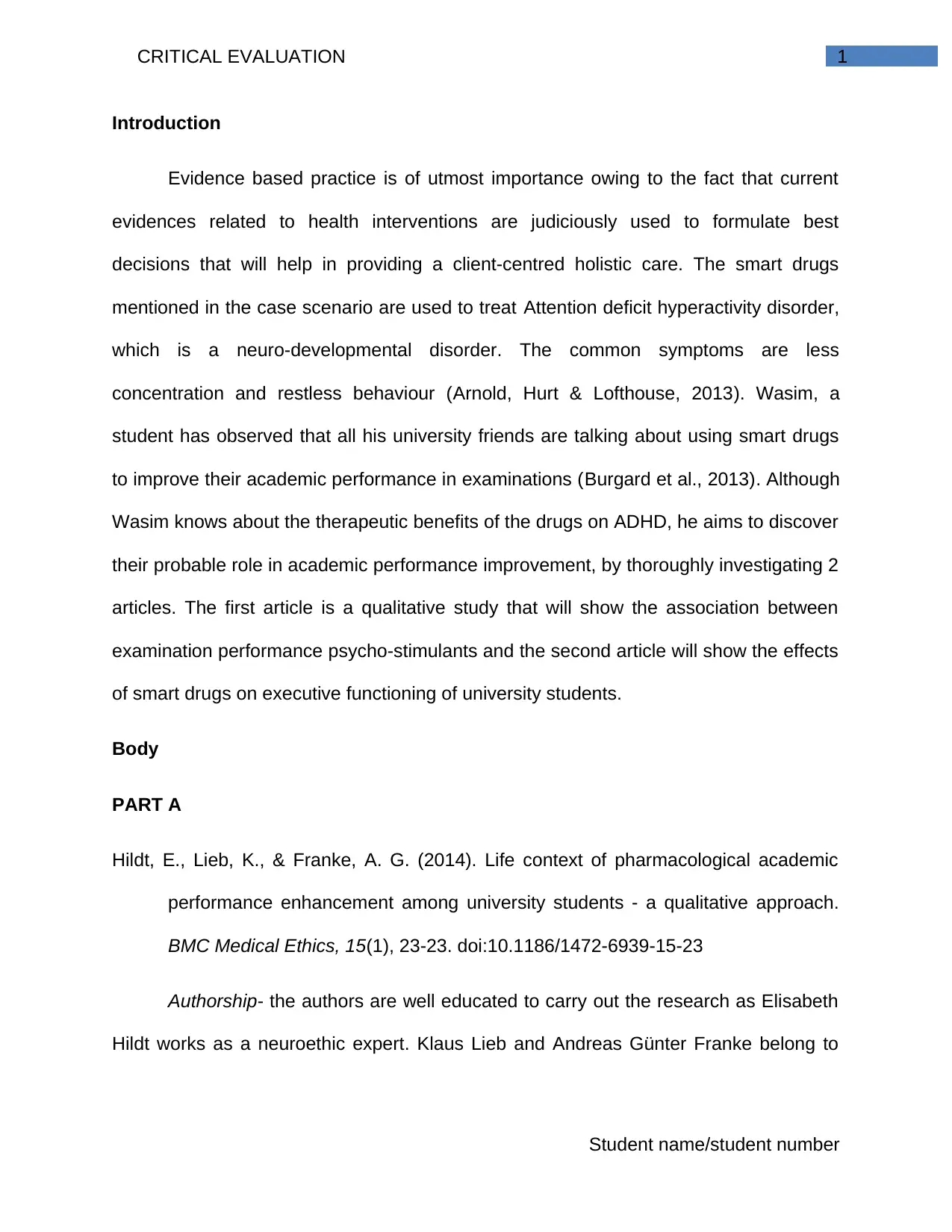
CRITICAL EVALUATION 1
Introduction
Evidence based practice is of utmost importance owing to the fact that current
evidences related to health interventions are judiciously used to formulate best
decisions that will help in providing a client-centred holistic care. The smart drugs
mentioned in the case scenario are used to treat Attention deficit hyperactivity disorder,
which is a neuro-developmental disorder. The common symptoms are less
concentration and restless behaviour (Arnold, Hurt & Lofthouse, 2013). Wasim, a
student has observed that all his university friends are talking about using smart drugs
to improve their academic performance in examinations (Burgard et al., 2013). Although
Wasim knows about the therapeutic benefits of the drugs on ADHD, he aims to discover
their probable role in academic performance improvement, by thoroughly investigating 2
articles. The first article is a qualitative study that will show the association between
examination performance psycho-stimulants and the second article will show the effects
of smart drugs on executive functioning of university students.
Body
PART A
Hildt, E., Lieb, K., & Franke, A. G. (2014). Life context of pharmacological academic
performance enhancement among university students - a qualitative approach.
BMC Medical Ethics, 15(1), 23-23. doi:10.1186/1472-6939-15-23
Authorship- the authors are well educated to carry out the research as Elisabeth
Hildt works as a neuroethic expert. Klaus Lieb and Andreas Günter Franke belong to
Student name/student number
Introduction
Evidence based practice is of utmost importance owing to the fact that current
evidences related to health interventions are judiciously used to formulate best
decisions that will help in providing a client-centred holistic care. The smart drugs
mentioned in the case scenario are used to treat Attention deficit hyperactivity disorder,
which is a neuro-developmental disorder. The common symptoms are less
concentration and restless behaviour (Arnold, Hurt & Lofthouse, 2013). Wasim, a
student has observed that all his university friends are talking about using smart drugs
to improve their academic performance in examinations (Burgard et al., 2013). Although
Wasim knows about the therapeutic benefits of the drugs on ADHD, he aims to discover
their probable role in academic performance improvement, by thoroughly investigating 2
articles. The first article is a qualitative study that will show the association between
examination performance psycho-stimulants and the second article will show the effects
of smart drugs on executive functioning of university students.
Body
PART A
Hildt, E., Lieb, K., & Franke, A. G. (2014). Life context of pharmacological academic
performance enhancement among university students - a qualitative approach.
BMC Medical Ethics, 15(1), 23-23. doi:10.1186/1472-6939-15-23
Authorship- the authors are well educated to carry out the research as Elisabeth
Hildt works as a neuroethic expert. Klaus Lieb and Andreas Günter Franke belong to
Student name/student number

CRITICAL EVALUATION 2
the Department of Psychiatry and Psychotherapy, University Medical Centre Mainz
(Germany). Franke is a trainee under the guidance of the former.
Research Aims- The study aimed to investigate the effects of illicit and
prescribed psycho-stimulants on academic performance. The effects of drugs such as,
methylphenidate and amphetamine on examination performance were assessed. The
student experiences were measured on administration of smart-drugs. Furthermore,
influence of several factors such as academic and peer pressure on academic
performance were also measured (Hildt, Lieb & Franke, 2014).
Design- Students were recruited from the University of Mainz campus, followed
by conduction of semi-structured, face-to-face interviews. The questions focused on
illicit or prescribed consumption of stimulants, individual perception of their effects on
academics and any observable negative effects. After being transcribed verbatim, the
responses were analysed systematically using a qualitative approach. The
transcriptions were analysed by 2 raters who were blind to the study. The categories of
responses were selected for final analysis on which both the raters showed agreement.
Findings- 18 out of 22 interviews were analysed. 4 students were reportedly
under the use of prescribed stimulants. Rest were involved in illicit drug usage. The
average age for the use of first stimulants was found to be 20.4 ± 2.88 years.The
stimulants were used for facilitating exam preparation, gaining study time, and pursuing
individual projects, out of academic domains (a career in music along with university
study). Time pressure and performance affected the intake. Reports suggested
increased in motivation and reduction in sleep time after drug usage (Farah et al.,
Student name/student number
the Department of Psychiatry and Psychotherapy, University Medical Centre Mainz
(Germany). Franke is a trainee under the guidance of the former.
Research Aims- The study aimed to investigate the effects of illicit and
prescribed psycho-stimulants on academic performance. The effects of drugs such as,
methylphenidate and amphetamine on examination performance were assessed. The
student experiences were measured on administration of smart-drugs. Furthermore,
influence of several factors such as academic and peer pressure on academic
performance were also measured (Hildt, Lieb & Franke, 2014).
Design- Students were recruited from the University of Mainz campus, followed
by conduction of semi-structured, face-to-face interviews. The questions focused on
illicit or prescribed consumption of stimulants, individual perception of their effects on
academics and any observable negative effects. After being transcribed verbatim, the
responses were analysed systematically using a qualitative approach. The
transcriptions were analysed by 2 raters who were blind to the study. The categories of
responses were selected for final analysis on which both the raters showed agreement.
Findings- 18 out of 22 interviews were analysed. 4 students were reportedly
under the use of prescribed stimulants. Rest were involved in illicit drug usage. The
average age for the use of first stimulants was found to be 20.4 ± 2.88 years.The
stimulants were used for facilitating exam preparation, gaining study time, and pursuing
individual projects, out of academic domains (a career in music along with university
study). Time pressure and performance affected the intake. Reports suggested
increased in motivation and reduction in sleep time after drug usage (Farah et al.,
Student name/student number
⊘ This is a preview!⊘
Do you want full access?
Subscribe today to unlock all pages.

Trusted by 1+ million students worldwide
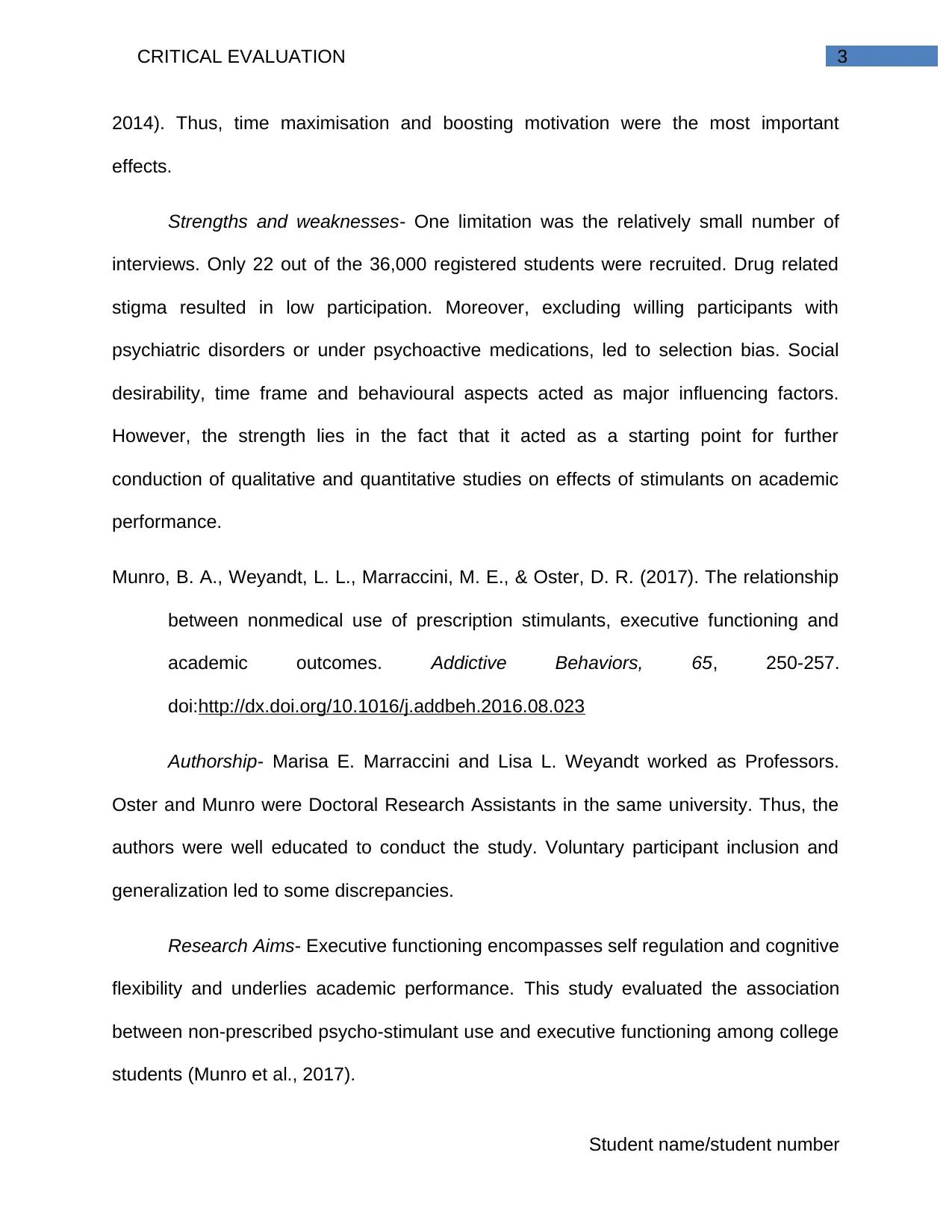
CRITICAL EVALUATION 3
2014). Thus, time maximisation and boosting motivation were the most important
effects.
Strengths and weaknesses- One limitation was the relatively small number of
interviews. Only 22 out of the 36,000 registered students were recruited. Drug related
stigma resulted in low participation. Moreover, excluding willing participants with
psychiatric disorders or under psychoactive medications, led to selection bias. Social
desirability, time frame and behavioural aspects acted as major influencing factors.
However, the strength lies in the fact that it acted as a starting point for further
conduction of qualitative and quantitative studies on effects of stimulants on academic
performance.
Munro, B. A., Weyandt, L. L., Marraccini, M. E., & Oster, D. R. (2017). The relationship
between nonmedical use of prescription stimulants, executive functioning and
academic outcomes. Addictive Behaviors, 65, 250-257.
doi:http://dx.doi.org/10.1016/j.addbeh.2016.08.023
Authorship- Marisa E. Marraccini and Lisa L. Weyandt worked as Professors.
Oster and Munro were Doctoral Research Assistants in the same university. Thus, the
authors were well educated to conduct the study. Voluntary participant inclusion and
generalization led to some discrepancies.
Research Aims- Executive functioning encompasses self regulation and cognitive
flexibility and underlies academic performance. This study evaluated the association
between non-prescribed psycho-stimulant use and executive functioning among college
students (Munro et al., 2017).
Student name/student number
2014). Thus, time maximisation and boosting motivation were the most important
effects.
Strengths and weaknesses- One limitation was the relatively small number of
interviews. Only 22 out of the 36,000 registered students were recruited. Drug related
stigma resulted in low participation. Moreover, excluding willing participants with
psychiatric disorders or under psychoactive medications, led to selection bias. Social
desirability, time frame and behavioural aspects acted as major influencing factors.
However, the strength lies in the fact that it acted as a starting point for further
conduction of qualitative and quantitative studies on effects of stimulants on academic
performance.
Munro, B. A., Weyandt, L. L., Marraccini, M. E., & Oster, D. R. (2017). The relationship
between nonmedical use of prescription stimulants, executive functioning and
academic outcomes. Addictive Behaviors, 65, 250-257.
doi:http://dx.doi.org/10.1016/j.addbeh.2016.08.023
Authorship- Marisa E. Marraccini and Lisa L. Weyandt worked as Professors.
Oster and Munro were Doctoral Research Assistants in the same university. Thus, the
authors were well educated to conduct the study. Voluntary participant inclusion and
generalization led to some discrepancies.
Research Aims- Executive functioning encompasses self regulation and cognitive
flexibility and underlies academic performance. This study evaluated the association
between non-prescribed psycho-stimulant use and executive functioning among college
students (Munro et al., 2017).
Student name/student number
Paraphrase This Document
Need a fresh take? Get an instant paraphrase of this document with our AI Paraphraser
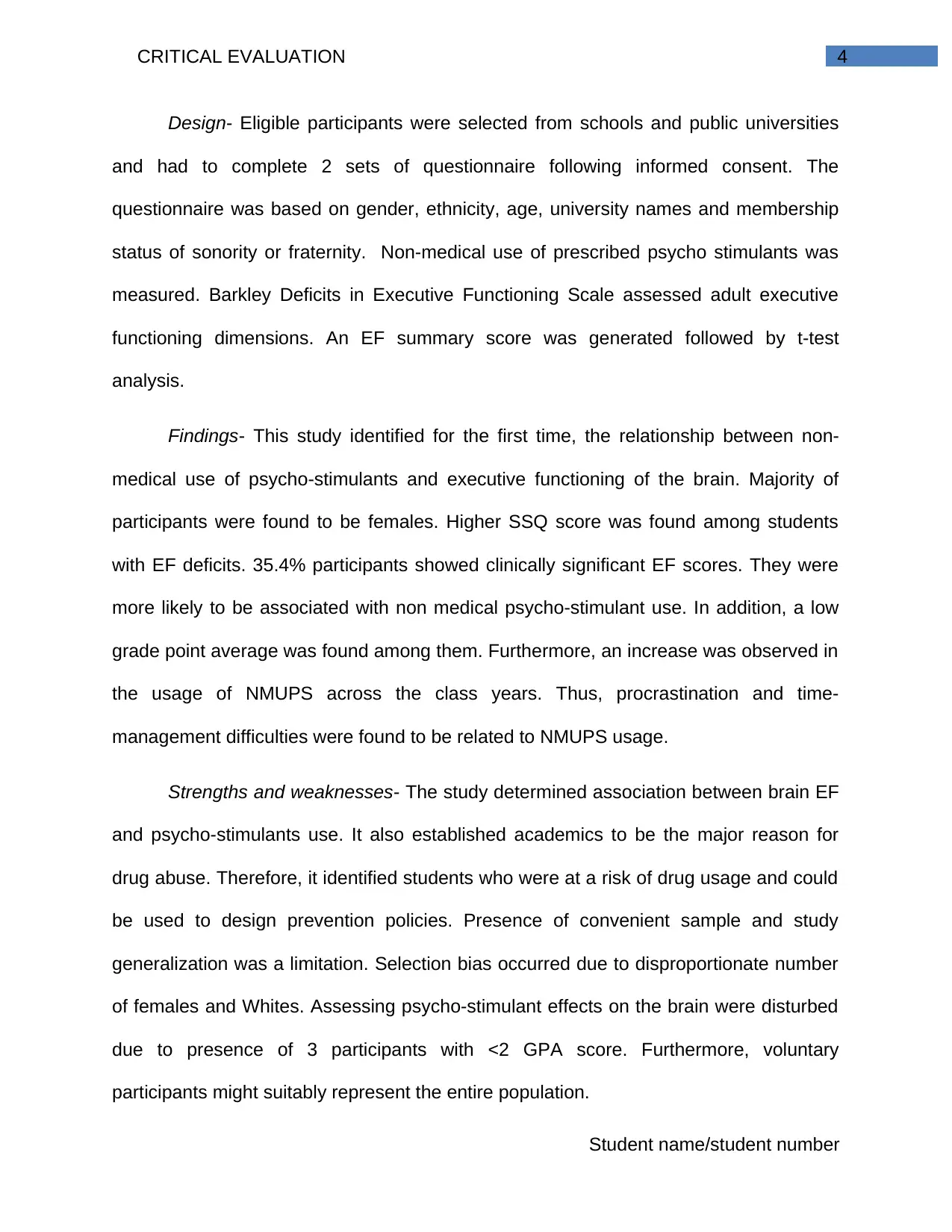
CRITICAL EVALUATION 4
Design- Eligible participants were selected from schools and public universities
and had to complete 2 sets of questionnaire following informed consent. The
questionnaire was based on gender, ethnicity, age, university names and membership
status of sonority or fraternity. Non-medical use of prescribed psycho stimulants was
measured. Barkley Deficits in Executive Functioning Scale assessed adult executive
functioning dimensions. An EF summary score was generated followed by t-test
analysis.
Findings- This study identified for the first time, the relationship between non-
medical use of psycho-stimulants and executive functioning of the brain. Majority of
participants were found to be females. Higher SSQ score was found among students
with EF deficits. 35.4% participants showed clinically significant EF scores. They were
more likely to be associated with non medical psycho-stimulant use. In addition, a low
grade point average was found among them. Furthermore, an increase was observed in
the usage of NMUPS across the class years. Thus, procrastination and time-
management difficulties were found to be related to NMUPS usage.
Strengths and weaknesses- The study determined association between brain EF
and psycho-stimulants use. It also established academics to be the major reason for
drug abuse. Therefore, it identified students who were at a risk of drug usage and could
be used to design prevention policies. Presence of convenient sample and study
generalization was a limitation. Selection bias occurred due to disproportionate number
of females and Whites. Assessing psycho-stimulant effects on the brain were disturbed
due to presence of 3 participants with <2 GPA score. Furthermore, voluntary
participants might suitably represent the entire population.
Student name/student number
Design- Eligible participants were selected from schools and public universities
and had to complete 2 sets of questionnaire following informed consent. The
questionnaire was based on gender, ethnicity, age, university names and membership
status of sonority or fraternity. Non-medical use of prescribed psycho stimulants was
measured. Barkley Deficits in Executive Functioning Scale assessed adult executive
functioning dimensions. An EF summary score was generated followed by t-test
analysis.
Findings- This study identified for the first time, the relationship between non-
medical use of psycho-stimulants and executive functioning of the brain. Majority of
participants were found to be females. Higher SSQ score was found among students
with EF deficits. 35.4% participants showed clinically significant EF scores. They were
more likely to be associated with non medical psycho-stimulant use. In addition, a low
grade point average was found among them. Furthermore, an increase was observed in
the usage of NMUPS across the class years. Thus, procrastination and time-
management difficulties were found to be related to NMUPS usage.
Strengths and weaknesses- The study determined association between brain EF
and psycho-stimulants use. It also established academics to be the major reason for
drug abuse. Therefore, it identified students who were at a risk of drug usage and could
be used to design prevention policies. Presence of convenient sample and study
generalization was a limitation. Selection bias occurred due to disproportionate number
of females and Whites. Assessing psycho-stimulant effects on the brain were disturbed
due to presence of 3 participants with <2 GPA score. Furthermore, voluntary
participants might suitably represent the entire population.
Student name/student number
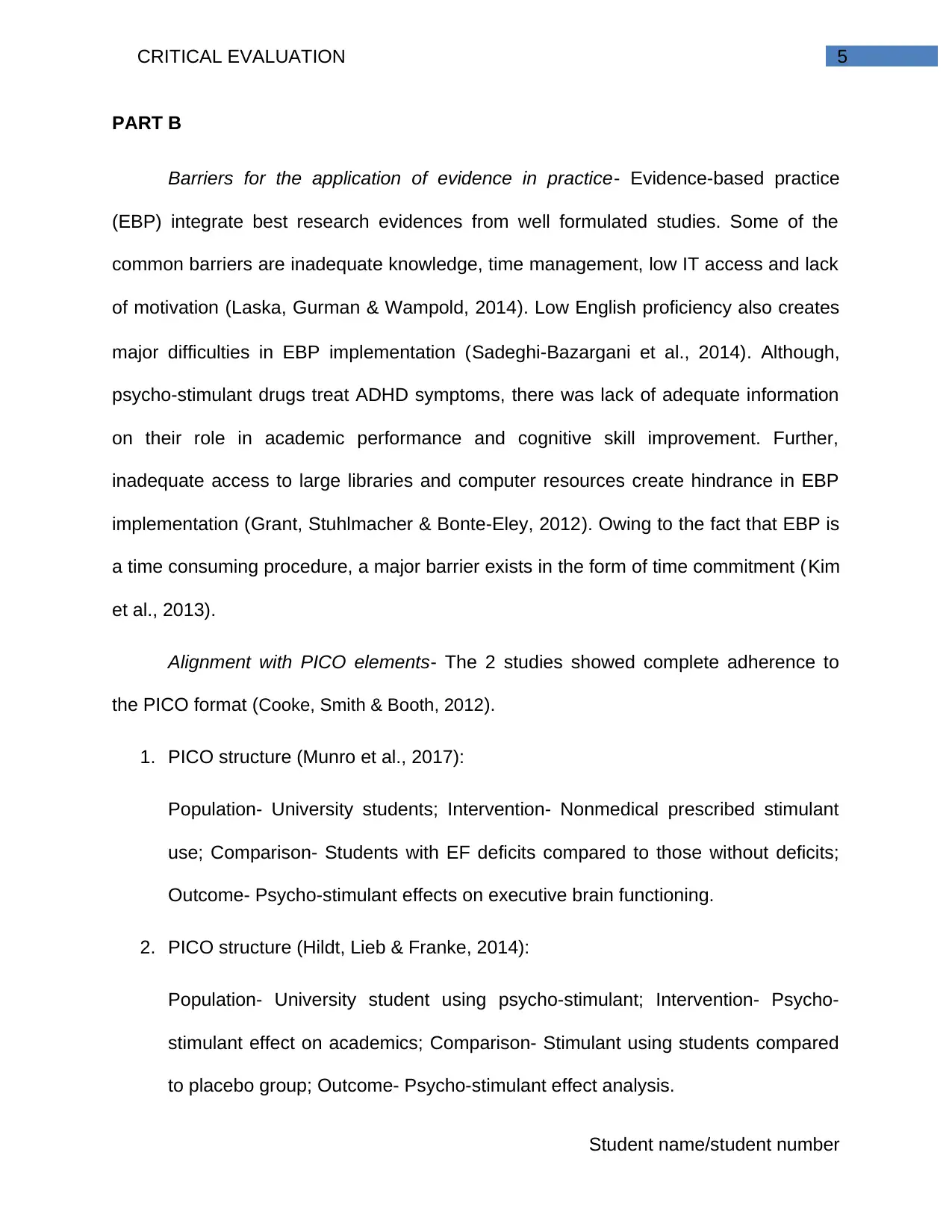
CRITICAL EVALUATION 5
PART B
Barriers for the application of evidence in practice- Evidence-based practice
(EBP) integrate best research evidences from well formulated studies. Some of the
common barriers are inadequate knowledge, time management, low IT access and lack
of motivation (Laska, Gurman & Wampold, 2014). Low English proficiency also creates
major difficulties in EBP implementation (Sadeghi‐Bazargani et al., 2014). Although,
psycho-stimulant drugs treat ADHD symptoms, there was lack of adequate information
on their role in academic performance and cognitive skill improvement. Further,
inadequate access to large libraries and computer resources create hindrance in EBP
implementation (Grant, Stuhlmacher & Bonte-Eley, 2012). Owing to the fact that EBP is
a time consuming procedure, a major barrier exists in the form of time commitment (Kim
et al., 2013).
Alignment with PICO elements- The 2 studies showed complete adherence to
the PICO format (Cooke, Smith & Booth, 2012).
1. PICO structure (Munro et al., 2017):
Population- University students; Intervention- Nonmedical prescribed stimulant
use; Comparison- Students with EF deficits compared to those without deficits;
Outcome- Psycho-stimulant effects on executive brain functioning.
2. PICO structure (Hildt, Lieb & Franke, 2014):
Population- University student using psycho-stimulant; Intervention- Psycho-
stimulant effect on academics; Comparison- Stimulant using students compared
to placebo group; Outcome- Psycho-stimulant effect analysis.
Student name/student number
PART B
Barriers for the application of evidence in practice- Evidence-based practice
(EBP) integrate best research evidences from well formulated studies. Some of the
common barriers are inadequate knowledge, time management, low IT access and lack
of motivation (Laska, Gurman & Wampold, 2014). Low English proficiency also creates
major difficulties in EBP implementation (Sadeghi‐Bazargani et al., 2014). Although,
psycho-stimulant drugs treat ADHD symptoms, there was lack of adequate information
on their role in academic performance and cognitive skill improvement. Further,
inadequate access to large libraries and computer resources create hindrance in EBP
implementation (Grant, Stuhlmacher & Bonte-Eley, 2012). Owing to the fact that EBP is
a time consuming procedure, a major barrier exists in the form of time commitment (Kim
et al., 2013).
Alignment with PICO elements- The 2 studies showed complete adherence to
the PICO format (Cooke, Smith & Booth, 2012).
1. PICO structure (Munro et al., 2017):
Population- University students; Intervention- Nonmedical prescribed stimulant
use; Comparison- Students with EF deficits compared to those without deficits;
Outcome- Psycho-stimulant effects on executive brain functioning.
2. PICO structure (Hildt, Lieb & Franke, 2014):
Population- University student using psycho-stimulant; Intervention- Psycho-
stimulant effect on academics; Comparison- Stimulant using students compared
to placebo group; Outcome- Psycho-stimulant effect analysis.
Student name/student number
⊘ This is a preview!⊘
Do you want full access?
Subscribe today to unlock all pages.

Trusted by 1+ million students worldwide
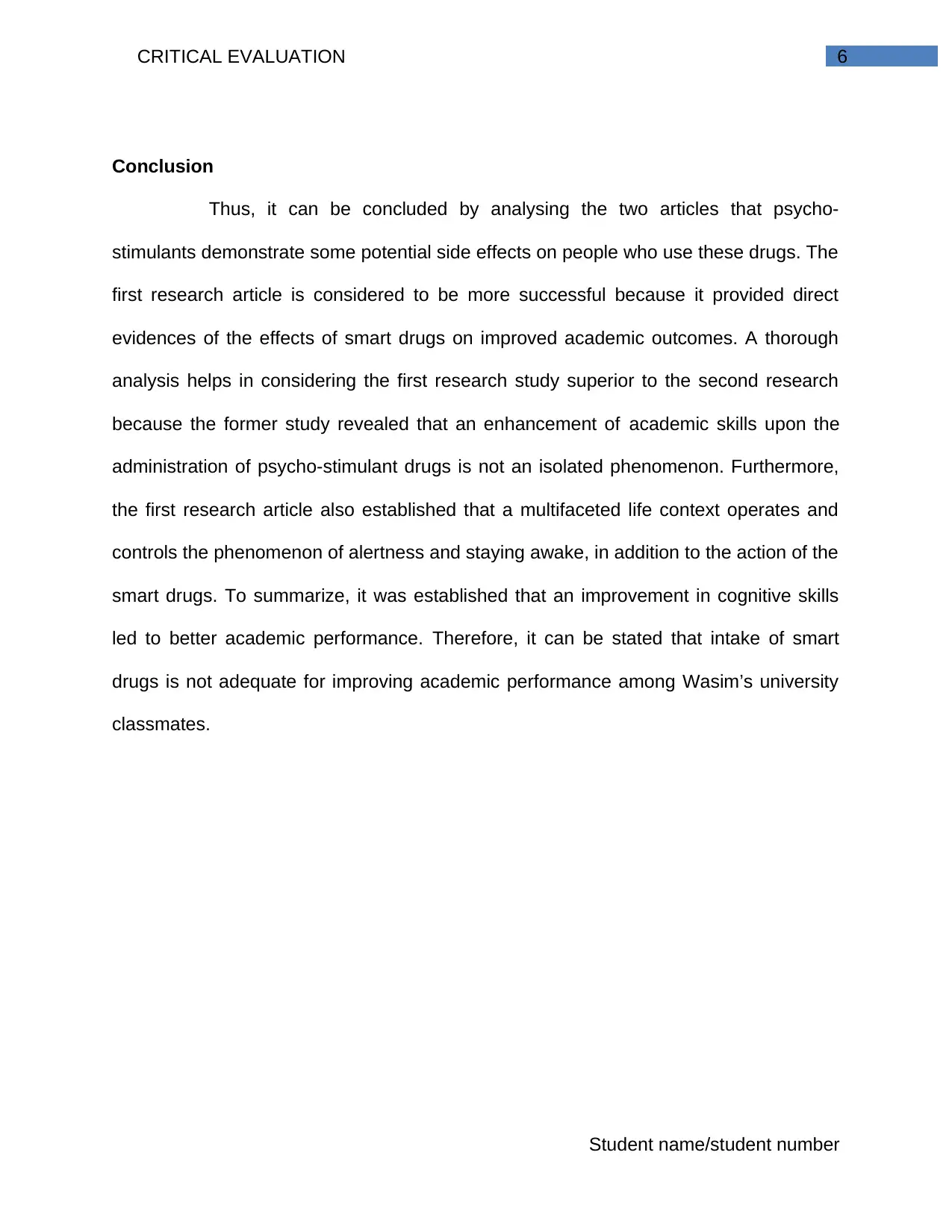
CRITICAL EVALUATION 6
Conclusion
Thus, it can be concluded by analysing the two articles that psycho-
stimulants demonstrate some potential side effects on people who use these drugs. The
first research article is considered to be more successful because it provided direct
evidences of the effects of smart drugs on improved academic outcomes. A thorough
analysis helps in considering the first research study superior to the second research
because the former study revealed that an enhancement of academic skills upon the
administration of psycho-stimulant drugs is not an isolated phenomenon. Furthermore,
the first research article also established that a multifaceted life context operates and
controls the phenomenon of alertness and staying awake, in addition to the action of the
smart drugs. To summarize, it was established that an improvement in cognitive skills
led to better academic performance. Therefore, it can be stated that intake of smart
drugs is not adequate for improving academic performance among Wasim’s university
classmates.
Student name/student number
Conclusion
Thus, it can be concluded by analysing the two articles that psycho-
stimulants demonstrate some potential side effects on people who use these drugs. The
first research article is considered to be more successful because it provided direct
evidences of the effects of smart drugs on improved academic outcomes. A thorough
analysis helps in considering the first research study superior to the second research
because the former study revealed that an enhancement of academic skills upon the
administration of psycho-stimulant drugs is not an isolated phenomenon. Furthermore,
the first research article also established that a multifaceted life context operates and
controls the phenomenon of alertness and staying awake, in addition to the action of the
smart drugs. To summarize, it was established that an improvement in cognitive skills
led to better academic performance. Therefore, it can be stated that intake of smart
drugs is not adequate for improving academic performance among Wasim’s university
classmates.
Student name/student number
Paraphrase This Document
Need a fresh take? Get an instant paraphrase of this document with our AI Paraphraser
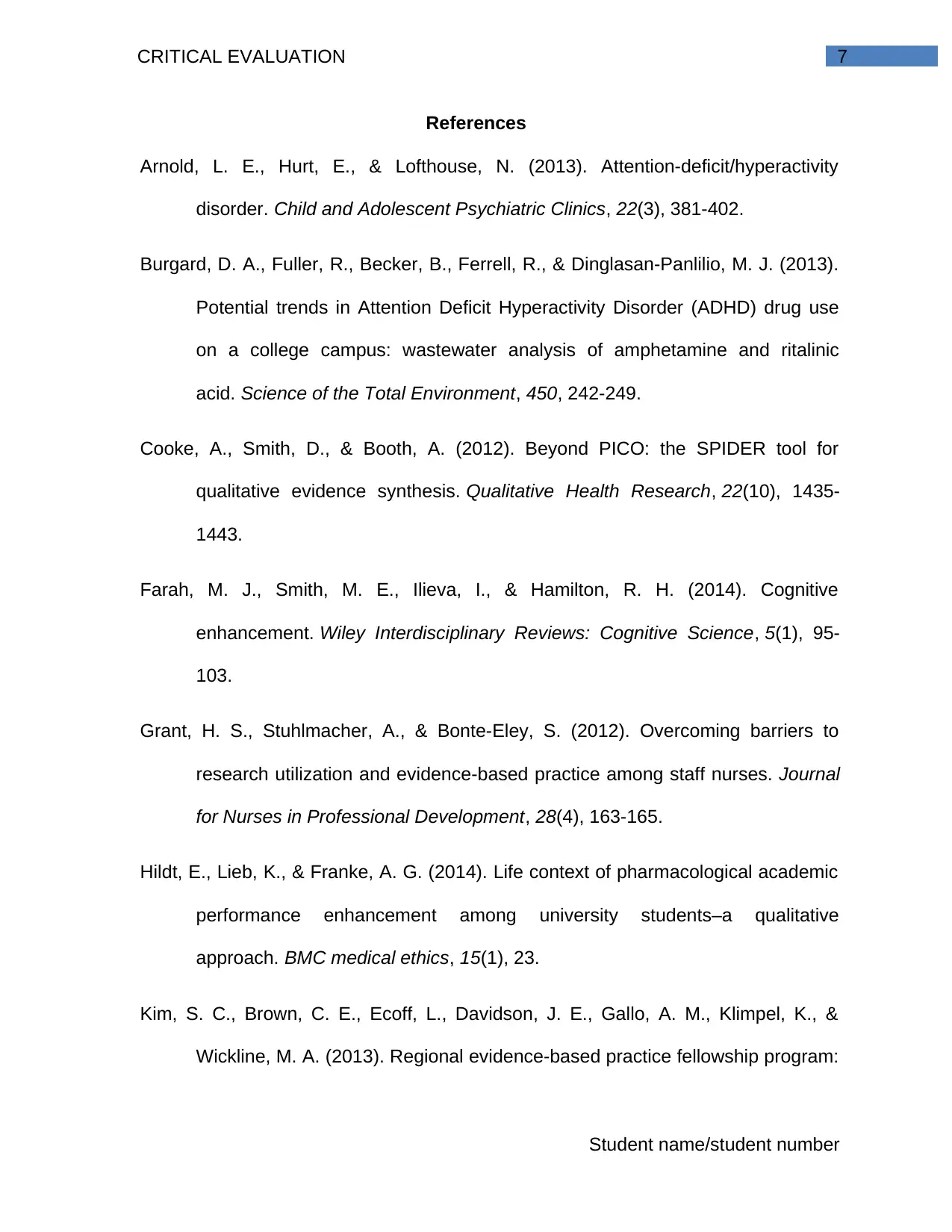
CRITICAL EVALUATION 7
References
Arnold, L. E., Hurt, E., & Lofthouse, N. (2013). Attention-deficit/hyperactivity
disorder. Child and Adolescent Psychiatric Clinics, 22(3), 381-402.
Burgard, D. A., Fuller, R., Becker, B., Ferrell, R., & Dinglasan-Panlilio, M. J. (2013).
Potential trends in Attention Deficit Hyperactivity Disorder (ADHD) drug use
on a college campus: wastewater analysis of amphetamine and ritalinic
acid. Science of the Total Environment, 450, 242-249.
Cooke, A., Smith, D., & Booth, A. (2012). Beyond PICO: the SPIDER tool for
qualitative evidence synthesis. Qualitative Health Research, 22(10), 1435-
1443.
Farah, M. J., Smith, M. E., Ilieva, I., & Hamilton, R. H. (2014). Cognitive
enhancement. Wiley Interdisciplinary Reviews: Cognitive Science, 5(1), 95-
103.
Grant, H. S., Stuhlmacher, A., & Bonte-Eley, S. (2012). Overcoming barriers to
research utilization and evidence-based practice among staff nurses. Journal
for Nurses in Professional Development, 28(4), 163-165.
Hildt, E., Lieb, K., & Franke, A. G. (2014). Life context of pharmacological academic
performance enhancement among university students–a qualitative
approach. BMC medical ethics, 15(1), 23.
Kim, S. C., Brown, C. E., Ecoff, L., Davidson, J. E., Gallo, A. M., Klimpel, K., &
Wickline, M. A. (2013). Regional evidence-based practice fellowship program:
Student name/student number
References
Arnold, L. E., Hurt, E., & Lofthouse, N. (2013). Attention-deficit/hyperactivity
disorder. Child and Adolescent Psychiatric Clinics, 22(3), 381-402.
Burgard, D. A., Fuller, R., Becker, B., Ferrell, R., & Dinglasan-Panlilio, M. J. (2013).
Potential trends in Attention Deficit Hyperactivity Disorder (ADHD) drug use
on a college campus: wastewater analysis of amphetamine and ritalinic
acid. Science of the Total Environment, 450, 242-249.
Cooke, A., Smith, D., & Booth, A. (2012). Beyond PICO: the SPIDER tool for
qualitative evidence synthesis. Qualitative Health Research, 22(10), 1435-
1443.
Farah, M. J., Smith, M. E., Ilieva, I., & Hamilton, R. H. (2014). Cognitive
enhancement. Wiley Interdisciplinary Reviews: Cognitive Science, 5(1), 95-
103.
Grant, H. S., Stuhlmacher, A., & Bonte-Eley, S. (2012). Overcoming barriers to
research utilization and evidence-based practice among staff nurses. Journal
for Nurses in Professional Development, 28(4), 163-165.
Hildt, E., Lieb, K., & Franke, A. G. (2014). Life context of pharmacological academic
performance enhancement among university students–a qualitative
approach. BMC medical ethics, 15(1), 23.
Kim, S. C., Brown, C. E., Ecoff, L., Davidson, J. E., Gallo, A. M., Klimpel, K., &
Wickline, M. A. (2013). Regional evidence-based practice fellowship program:
Student name/student number

CRITICAL EVALUATION 8
Impact on evidence-based practice implementation and barriers. Clinical
Nursing Research, 22(1), 51-69.
Laska, K. M., Gurman, A. S., & Wampold, B. E. (2014). Expanding the lens of
evidence-based practice in psychotherapy: a common factors
perspective. Psychotherapy, 51(4), 467.
Munro, B. A., Weyandt, L. L., Marraccini, M. E., & Oster, D. R. (2017). The
relationship between nonmedical use of prescription stimulants, executive
functioning and academic outcomes. Addictive behaviors, 65, 250-257.
Sadeghi‐Bazargani, H., Tabrizi, J. S., & Azami‐Aghdash, S. (2014). Barriers to
evidence‐based medicine: a systematic review. Journal of evaluation in
clinical practice, 20(6), 793-802.
Student name/student number
Impact on evidence-based practice implementation and barriers. Clinical
Nursing Research, 22(1), 51-69.
Laska, K. M., Gurman, A. S., & Wampold, B. E. (2014). Expanding the lens of
evidence-based practice in psychotherapy: a common factors
perspective. Psychotherapy, 51(4), 467.
Munro, B. A., Weyandt, L. L., Marraccini, M. E., & Oster, D. R. (2017). The
relationship between nonmedical use of prescription stimulants, executive
functioning and academic outcomes. Addictive behaviors, 65, 250-257.
Sadeghi‐Bazargani, H., Tabrizi, J. S., & Azami‐Aghdash, S. (2014). Barriers to
evidence‐based medicine: a systematic review. Journal of evaluation in
clinical practice, 20(6), 793-802.
Student name/student number
⊘ This is a preview!⊘
Do you want full access?
Subscribe today to unlock all pages.

Trusted by 1+ million students worldwide
1 out of 9
Related Documents
Your All-in-One AI-Powered Toolkit for Academic Success.
+13062052269
info@desklib.com
Available 24*7 on WhatsApp / Email
![[object Object]](/_next/static/media/star-bottom.7253800d.svg)
Unlock your academic potential
Copyright © 2020–2025 A2Z Services. All Rights Reserved. Developed and managed by ZUCOL.





